Reviews
In Guatemala, the Bienal de Arte Paiz Offers an Object Lesson in Community-Based Art Done Right
The event both centers Central American production and decenters art from its traditional spaces.

The event both centers Central American production and decenters art from its traditional spaces.

John Pluecker

On my last day in Guatemala, after two weeks of involvement in various art and literary activities, I stepped out of a van in the Kaqchikel Mayan community of Sumpango to attend what the 21st Bienal de Arte Paiz had billed as a day-long festival of street theater, kite-flying, and Mayan ceremony. Initially, I was reluctant even to go to the event. I had heard four buses would leave from the capital to attend and it seemed like an invasion was planned.
Over the years, I’ve been involved in other arts events that take place in community settings that ended up feeling either overly policed and controlled by the presenting organization or alternately like an invasive and colonizing occupation. So I was skeptical about the ability of the biennial to pull this event off, to create a shared sense of community among all attendees.
Upon arrival, my fears initially seemed realized. A motley crew of international visitors and Guatemalan artists and arts enthusiasts from the capital descended from the vans. An array of costumed performers were lined up in front of the municipal offices, readying themselves to perform a work of street theater called el baile de los moros y cristianos, a piece originally from Spain highlighting the conflict between Moors and Spaniards on the Iberian peninsula, but re-conceived and syncretically altered and appropriated by indigenous Guatemalans. An array of people from the local community were seated on high sidewalks or beginning to gather. A number of particularly obtrusive and unaware out-of-town visitors grabbed their cameras and set to snapping aggressively. Was this a pre-planned tourist attraction showing a bit of “local color” or something else entirely?
My decision to attend this year’s 21st iteration of the Bienal Paiz in Guatemala—the largest biennial in Central America and the second-oldest in Latin America after São Paulo, which is also underway this week—came in the midst of a crisis around family separation in the United States, killings of migrants at the border, and President Trump’s crackdown on undocumented and even documented immigration. Central American migrants have been the focus of relentlessly negative media coverage, the object of the ire and disdain of the Trumpian Republican party. So I was interested to see how a Central American biennial would respond.
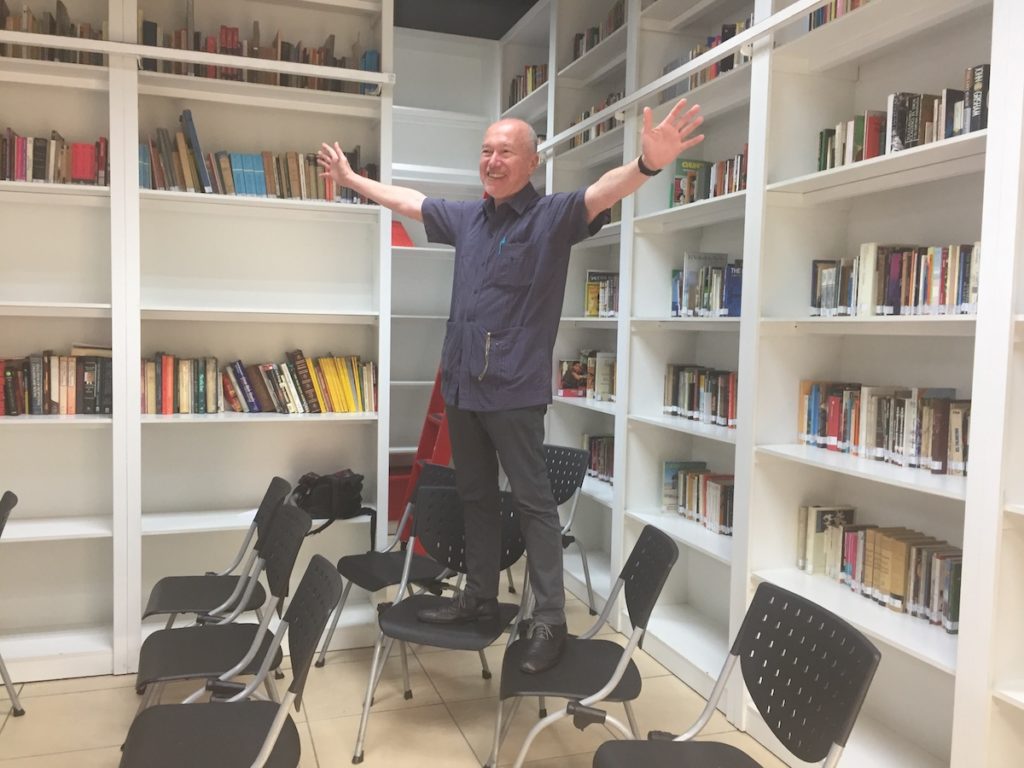
Gerardo Mosquera, chief curator of the 21st Bienal de Arte Paiz. Image courtesy Fundación Paiz.
On the ground, I realized that the Bienial Paiz is operating from a different script entirely, looking in other directions, away from the constant tweetstorms and the latest abhorrent US scandal. This biennial is pursuing a deeper, longer-term set of inquiries about decolonization, community-based arts, and the meaning of the contemporary in a context of post-civil-war violence, dire inequities, and an international art world that largely ignores Central American artistic production.
According to curators Gerardo Mosquera, Maya Juracán, and Laura Wellen, the thrust of this year’s biennial is a movement into the “Mas allá” or “Beyond.” They imagine a more inclusive and conversational biennial, decentralized in both space and time: a move away from what is known or accepted, into other spheres and other geographies, away from the circuits of the international art market largely confined to certain zones of the capital city—and even expanding the imagination towards space and interstellar travel.
The biennial centers artistic production from Central America. One of the curators’ principal strategies is to recognize that contemporary art does not live exclusively in the capital’s white cube galleries, but rather in a variety of different spaces: from wheat-pasted posters on the streets to a patio of a university building to indigenous communities far from Guatemala City. Indeed, the strength of the 21st Bienal de Arte Paiz is rooted in its desire to connect with communities otherwise marginalized within Central America. Because of that, the biennial provides a variety of artistic and curatorial models for community engagement and decolonial strategies more broadly.
I never saw the word “decolonization” mentioned in the materials for the Bienal de Arte Paiz. Yet in my own meanderings through a number of events, exhibitions, and excursions in mid-August, I found myself returning continually to the concept and its possibilities. As art historian Kency Cornejo and Guatemalan artist Benvenuto Chavajay point out in this video from the Hemispheric Institute, many Central American artists are actively pursuing a “return”—as Chavajay describes it, a return to the root, to communities of origin, and to an epistemology and ontology grounded in indigenous lifeways, pasts, and futures. Cornejo explains that many of these artists do not use the term “decolonization” to describe their work, though this “return” is arguably an enactment of that process.
One of the most striking and powerful representations of this biennial’s focus on the communal is found in the work of H.I.J.O.S., a collective of young people dedicated to reviving the historical memory of the individuals disappeared and killed during the civil war in Guatemala from 1960 to 1996.
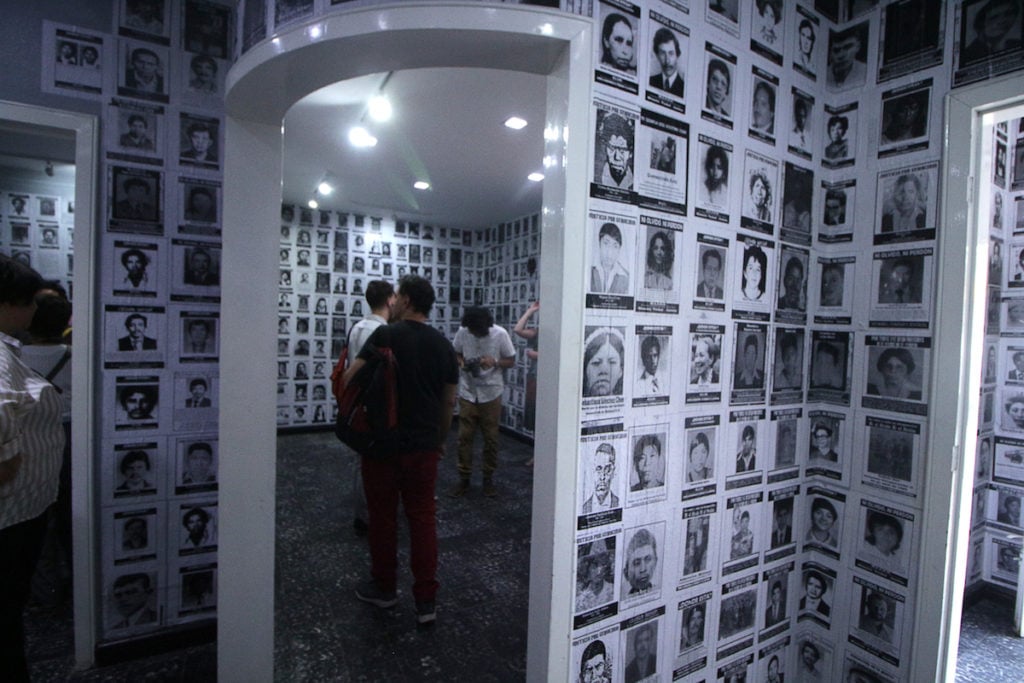
Installation view of work by H.I.J.O.S. in the 21st Bienal de Arte Paiz. © Fundación Paiz. Photo by Alejandro García.
The biennial invited this activist organization to do an installation. After intense internal debate, H.I.J.O.S. accepted, wheat-pasting the entire structure of a house in downtown Guatemala City inside and out with photocopies of images of people disappeared and massacred during the internal armed conflict, along with a short narrative explaining who each individual was, what they fought for, and how they were lost.
These wheat-pasted images are found on walls throughout the capital and the country. Nevertheless, seeing them re-framed as part of the biennial shifts the frame, provoking an important reconceptualization of what “contemporary art” in Guatemala might be.
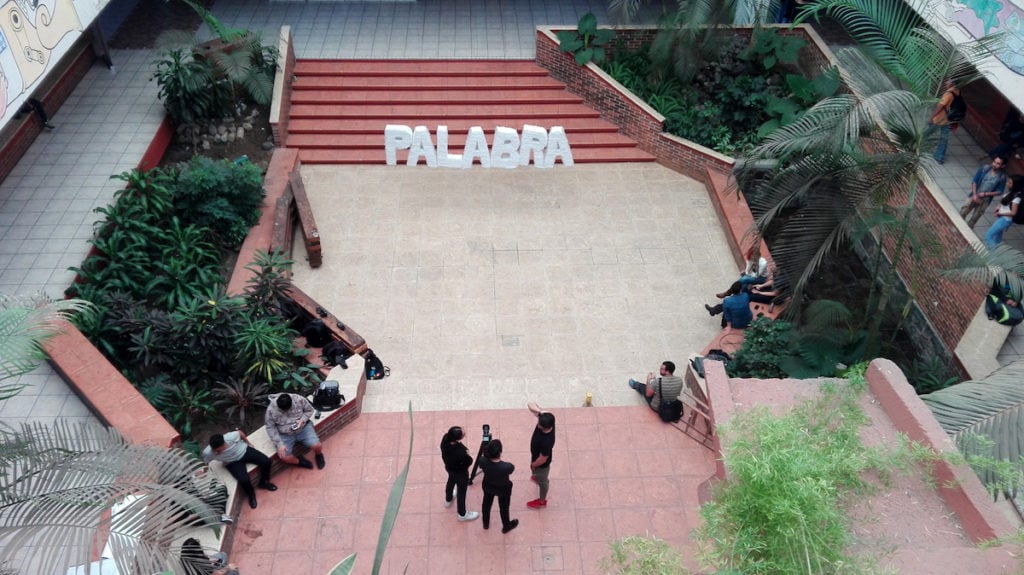
Preparing for a performance by El Colectivo. © Fundación Paiz. Photo by Alejandro García.
On Friday, August 18, I attended a series of events at the Universidad de San Carlos de Guatemala, the biggest and oldest Guatemalan university, founded during the colonial era. In an action by El Colectivo—a collaboration between Guatemalan artists José Oquendo and Christopher Torres Ticas—seven white piñatas spelling out the word PALABRA were ritualistically mauled in a performance that solicited participation from the audience in attendance and from students in the airy interior patio of the architecture building of the university. Symbolically, they seemed to be smashing the written WORD, a gesture towards another kind of knowledge, not dependent on pure rationalization, rooted in oral culture.
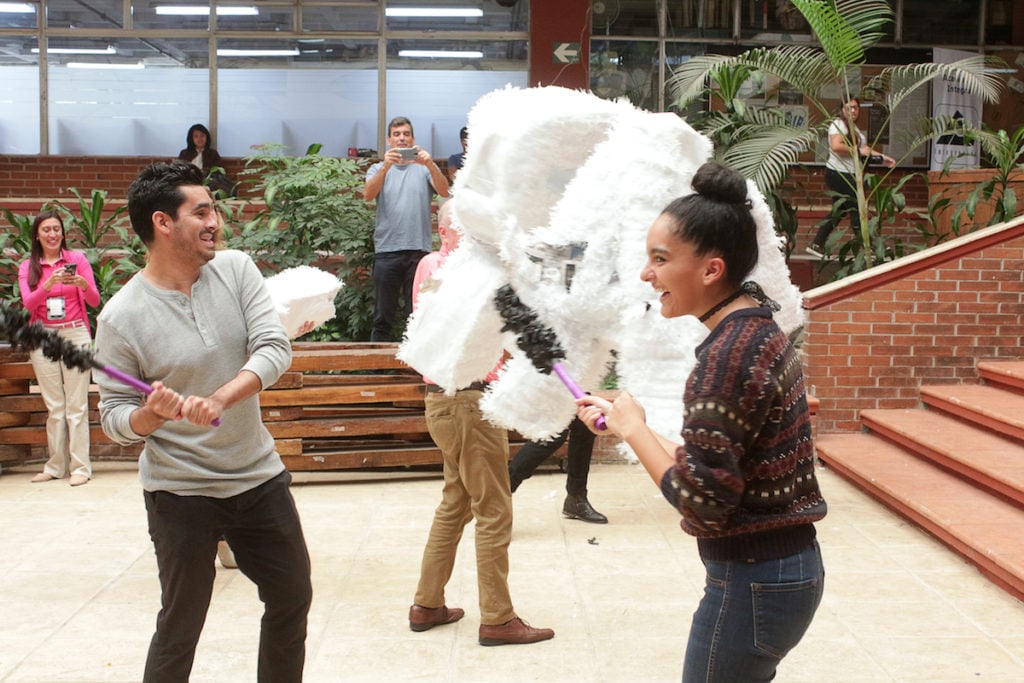
The performance by El Colectivo in the 21st Bienal de Arte Paiz. © Fundación Paiz. Photo by Alejandro García.
Adding poetry to the action, the interior walls of the universidad building is home to two other pieces: a mural from the 1970s by Arnaldo Ramírez Amaya on the second floor that denounces the way university education historically has converted students not into critical thinkers but rather into tools of US-backed corrupt governments and corporate exploitation. Two other artworks on the third floor by Bernabé Arévalo are large-scale, three-dimensional photographs made from archival footage of military operations during the Armed Internal Conflict in Guatemala.
Each of these artworks would have been enough on its own. Taken in sum, the impact was unquestionable. Twenty-two years after peace accords were signed in Guatemala, the layers of history are still thick. A new generation of artists is looking backward to the conflict, questioning the inherited interpretations of that history, metaphorically breaking the received “WORD” that has defined that history inaccurately.
The work of the Salvadoran artist Simón Vega also reimagined historical events, while re-orienting our gaze away from the hyper-local and into outer space. For the biennial, Vega made a large-scale installation called Apollo-Soyuz-Chapultepec, re-creating the docking of the Apollo and Soyuz satellites from the July 1975 first joint US-Soviet space flight. This was the same year the Miss Universe pageant was held in San Salvador, coinciding with a large-scale student massacre the same month at the hands of the government.

Installation view of Simón Vega’s Apollo-Soyuz-Chapultepec in the 21st Bienal de Arte Paiz. Image courtesy Fundación Paiz.
This rasquache piece drew on tropical building conventions common in marginalized communities in El Salvador. At the same time, its subject matter pointed out that while these satellites were coming together in space, on the ground “Third World” countries like El Salvador were both host to capitalist fantasy theater like Miss Universe and simultaneously torn apart by this international battle between capital-C Communism and Capitalism. The effects of the Cold War are still reverberating across Central America. Vega turns our attention to this fact in a humorous and irreverent way.
Perhaps the clearest sense of decolonial possibilities in this Guatemalan biennial can be found in the decision to work with three indigenous communities removed from the capital: San Pedro La Laguna, San Juan Comalapa, and Sumpango.

Murals in San Pedro for the 21st Bienal de Arte Paiz.. © Fundación Paiz. Photo by Alejandro García.
In the first town, the Colectivo Canal Cultural worked with the biennial to produce a series of startling murals depicting community heroes. In San Juan Comalapa, the biennial partnered with local poets, painters, and community leaders to undertake the restoration of a Mayan ceremonial site.
Finally, in Sumpango, the Panamanian artist Humberto Vélez was commissioned to co-organize a day-long festival in conjunction with the local community and an array of artists and leaders. Sumpango is internationally renowned for its gigantic kites called barriletes and its many festivals. In a telling move, “Community of Sumpango” was actually listed as one of the invited artists to the biennial.
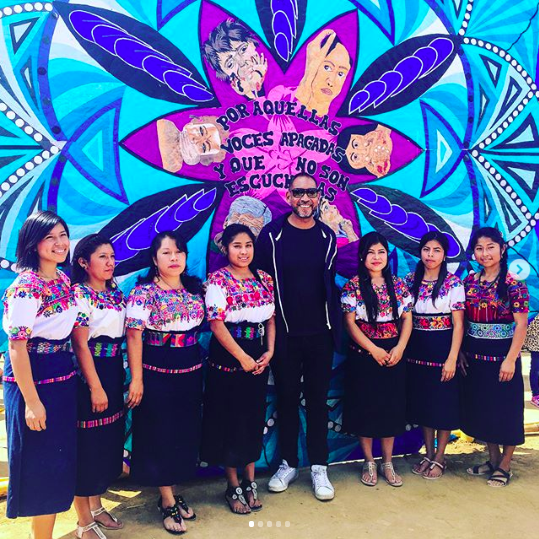
Humberto Vélez and performers from el baile de los moros y cristianos. Image courtesy Fundación Paiz.
Which brings us back to the moment of stepping out of the van in Sumpango, with all of my fears that the event could devolve into tourist spectacle. In fact, I was pleasantly surprised as the street theater piece began. As more people from Sumpango gathered, the irritating minority of intrusive, out-of-town photographers became increasingly easy to tune out. Personally, I decided not to take pictures and to focus on looking and observing.

A performance in Sungpango for the 21st Bienal de Arte Paiz. © Fundación Paiz. Photo by Alejandro García.
The performance was strikingly beautiful: the costumes, rhythms, and melodies of the accompanying musical instruments, the dancing, and the pride and enthusiasm shown by community members. Throngs of people continued to arrive from all around the town: people of all ages, many in indigenous garb snapping pictures and recording video just as intently as the outsiders.
Vélez had worked assiduously with local folks to initiate this procession through the town. This procession wound through the narrow streets, past the local cemetery, and onto the fairgrounds where the annual giant kite festival is held. There, I ran into Kakchikel poet and artist friends from San Juan Comalapa—Negma Janetth Coy and Noé Roquel—who had come to see this historic event with their children. Both were excited to see that the biennial had made the decision to expand its reach outside of the capital.

A performance in Sungpango for the 21st Bienal de Arte Paiz. © Fundación Paiz. Photo by Alejandro García.
Huge barriletes towered over the fairgrounds, and the public gathered around an area where pine needles had been arranged in a large circle. In the center, an array of candles marked the four directions and a dozen Mayan spiritual leaders prepared for a ceremony to mark the occasion. After the ceremony, local experts worked in teams to launch a number of the huge kites into the air, pulling on long ropes and scurrying intently around the fairground to keep them aloft.
Afterwards, all of the town and visitors were invited to partake in a lunch together, which sealed the sense of shared communality, cooperation, and horizontality.
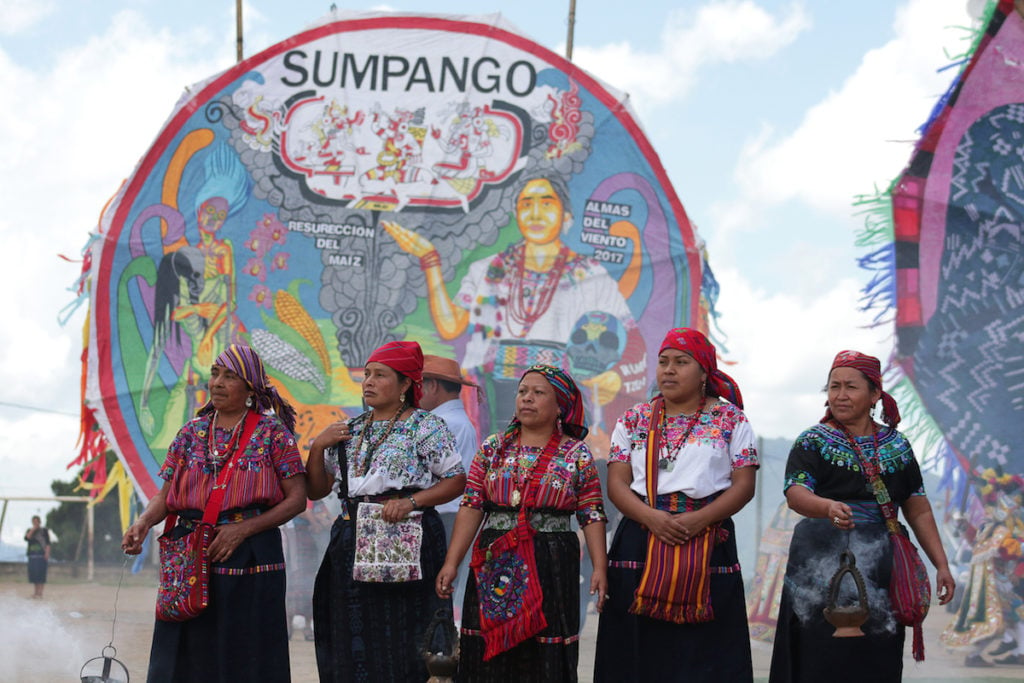
A performance in Sungpango for the 21st Bienal de Arte Paiz. © Fundación Paiz. Photo by Alejandro García.
I have been in enough art events in marginalized communities over the years to have seen hundreds of ways that this sort of event can go dreadfully wrong. But I didn’t see that wrongness on display on this day. The spirit of the day was surely the product of months of preparation and thousands of small decisions made cooperatively by Vélez and multiple partners in the community of Sumpango.
In an essay on Vélez, Luis Caminitzer says that the artist conceives of his work as an “aesthetics of collaboration.” This is what I felt: Not artist as invader or leader or even instigator, but artist as collaborator with and amplifier of a talented and organized community.
So why should a Biennial in Guatemala do this sort of work in communities that have their own millinary traditions of autonomous cultural production?
The gesture of outreach and collaboration is valuable because making the “Community of Sumpango” one of the invited artists re-defines what is understood as “contemporary art.” It asserts clearly that the “contemporary” is be found outside of the white cube. And it works against hierarchical definitions that place indigenous or traditional arts on an inferior level, always in the past, never present- or future-oriented.
Whether in a gallery or on the street, at the university or in Sumpango, the 21st iteration of the Bienal Paiz was noteworthy for its ambitious reach and its commitment to centering all forms of cultural production in Central America. There is much incisive work being made in Central America right now. The art world would be wise to turn its gaze and recognize its power to re-orient thinking—away from the latest right-wing scandal and to the potential for a more lasting kind of dialogue.
The 21st Bienal de Arte Paiz, “Más Allá,” is on view through September 16, 2018.